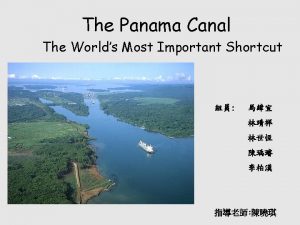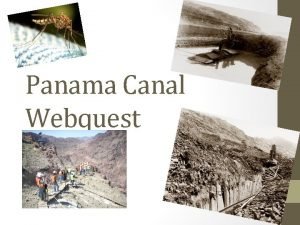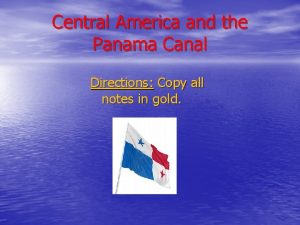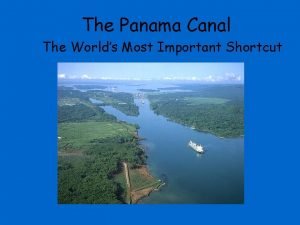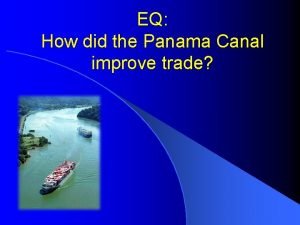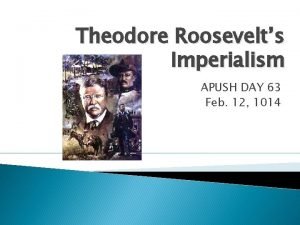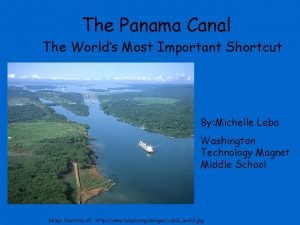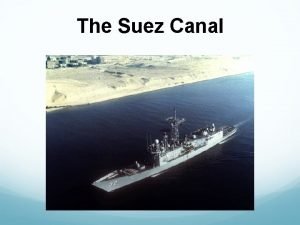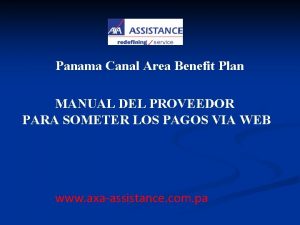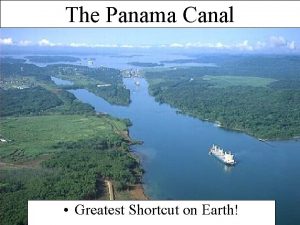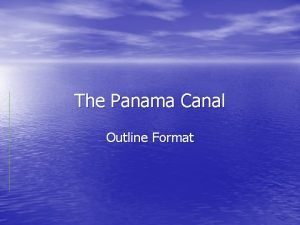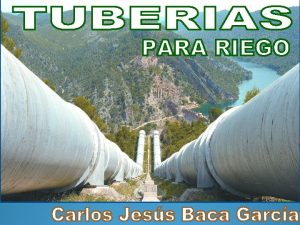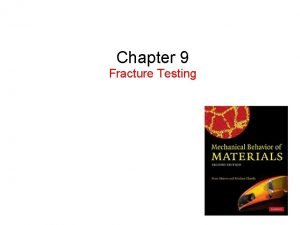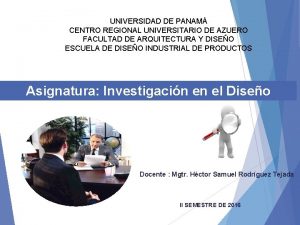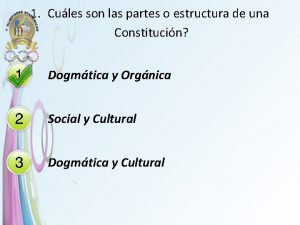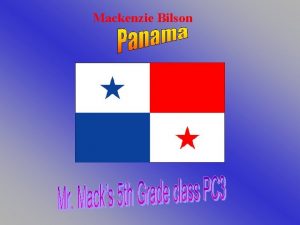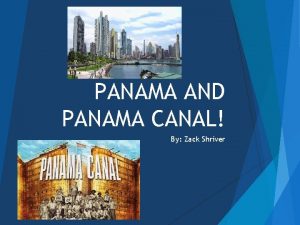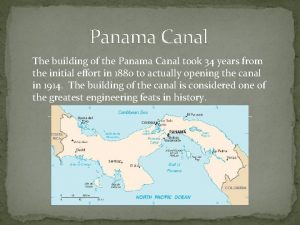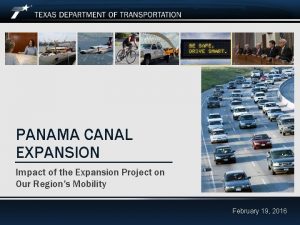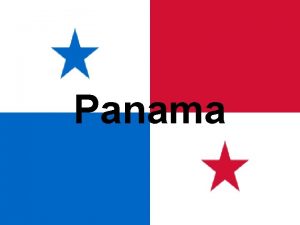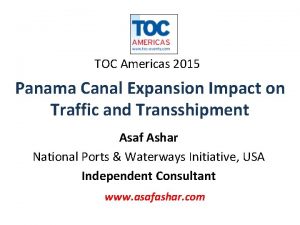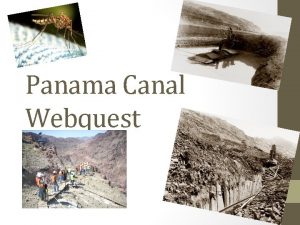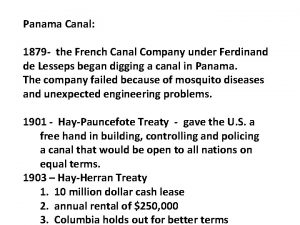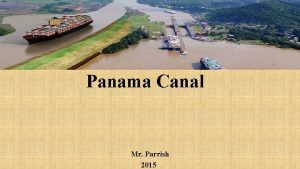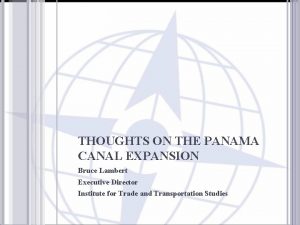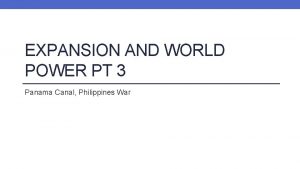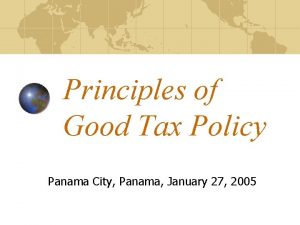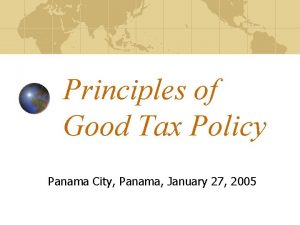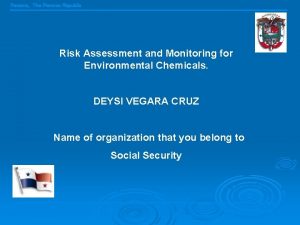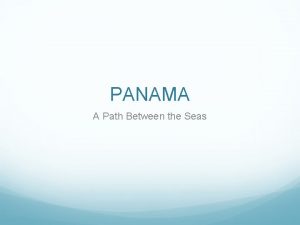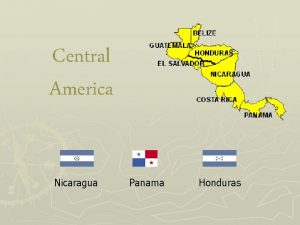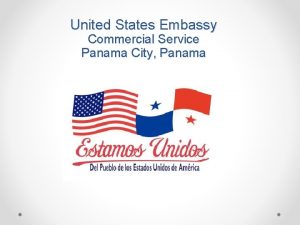The Impact of the Panama Canal Expansion on





















- Slides: 21

The Impact of the Panama Canal Expansion on Ship design and trade Elizabeth Lindstad Sintef Ocean AS: The merger of Norwegian Marine Technology Research Institute (MARINTEK), SINTEF Fisheries and Aquaculture, and the environmental technology group of SINTEF Materials and Chemistry from January 2017


In 2006, The Panama Canal Authorities decided to build new canal locks to enable significantly larger vessels to pass through the canal • • • Achieve economies of scale by employing larger vessels in trades through the canal, to reduce transport costs. Enable vessels too large for the existing canal, to re-route and thus reduce their voyage length and cost. Make the sea-route from Asia through the canal directly to the east coast of the US more competitive vis-à-vis the west coast and the landbridge route across the country to the east coast. The Old Locks Maximum Beam 32. 26 meter Draft 12. 04 m Length 290 m The New Locks Maximum Beam 49 m Draft 15. 2 m Length 360 m Source of drawing and map: Dagens Industri 15 January 2013 3

Ship Design principles • Seagoing vessels have traditionally been designed to operate at their boundary speed based on hydrodynamic considerations. • For any given hull form, the boundary speed can be defined as the speed range where the resistance coefficient goes from an almost nearly constant value to rise rapidly as speed increases. • For an average Panamax bulker or tanker with block coefficient in the 0. 85 to 0. 9 range (1. 0 for a shoebox) the boundary speed area starts at 12 – 13 knots, with a gradual increase in the resistance coefficient, which approaches infinity at speeds above 16 – 17 knots. • Higher fuel prices and growing environmental concerns have challenged the practice of maximising cargo-carrying ability and the practice of powering vessels to operate at their boundary speeds.

Alternative hull forms for a dry bulk Panamax of 80 000 dwt (displacement 92 000 ton Beam - Block 28. 2 m – 1. 0 32, 3 m – 0. 87 56. 0 m – 0. 5 38. 0 m – 0. 75

Slender hull forms – Boundary speed -1. 4*Cb)*(Lpp/0. 304)0. 5 (Silverleaf & Dawson 1996) Vb=(1. 7

The Maximum economic speed for a design is a function of the fuel cost

Low fuel prices favours fullbodied bulk and tank designs 8

Example of typical Block coeffisients and how increasing the beam, or the length, or both enables more slender vessels Source: Lindstad, H, 2015. Assessment of Bulk designs Enabled by the Panama Canal expansion. (SNAME) Transactions 121, page 590 -610, ISSN 0081 1661

• Out of all global restrictions, none had the impact on vessel design as the original Panama Canal locks dating back to 1914 • Apart from a few scientific papers, there has been relatively little focus on how the Canal's expansion will influence ship design and thus the energy efficiency of the global merchant shipping fleet. Source : MT- Marine Technology, page 42 – 46. Volume 53, Issue 4, October 2016

Expansion Impact – Container and carriers built for the new locks

DNV-GL VLCC TRIALITY a block of 0. 6 compared to 0. 8 for a conventional vessel -> a slender design 12

Laden and ballast voyage cost per as a function of vessel speed 9000 nm roundtrip with a 110' dwt Aframax (Fuel = 600 USD/ton) Source: Lindstad and Eskeland 2015 Low carbon maritime transport: How speed, size and slenderness amounts to Substantial Capital Energy Substitution. Transportation Research Part D 41

Fuel and cost per ton transported as a function of: vessel design – vessel size and vessel speed 900 USD/ ton of fuel Source: Lindstad and Eskeland 2015 Low carbon maritime transport: How speed, size and slenderness amounts to Substantial Capital Energy Substitution. Transportation Research Part D 41

Building more slender bulk and tank vessels might be the easiest way to meet EEDI - IMO requirements


Potential reduction in CO 2

2050 BAU scenario' s for shipping and reduction potentials identified through previous studies Fig 1: Lindstad 2016, own calculations and adapted from Bows-Larkin et al. (2015) Shipping charts a high carbon course. Nat. Clim. Chang. 5 a FIG. 2 Annual CO 2 emissions from the global shipping fleet, distinguished by business-as-usual and reduction scenario pathways (Bouman et al. 2017)

CO 2 emission reduction potential from individual measures Source: Bouman et al 2017

MAIN GOALS POTENTIAL AREAS SAVINGS UP TO 83% 30% EMISSIONS REDUCTION RESEARCH AREAS ENERGY EFFICIENCY MARITIME CLUSTER COMPETITIVENESS HULL DESIGN and Block Cofficient 10% 45% 35% 25% POWER SYSTEMS AND FUELS 20% NOVEL PROPULSION & PROPULSION OPTIMIZATION 30% 50% 60% VESSEL PERFORMANCE SIMULATION R L N IO S BA ISS ION GLO ING M EM LAT AR U W EG D EE I EL FU ST CO EOI E Y E IV OG N IT E OL TIO PET TAG N A M AN CH V CO AD TE NO IN URGENCY - CHALLENGES OF MARITIME INDUSTRY

 World shortcut panama canal
World shortcut panama canal Erie canal political cartoon
Erie canal political cartoon Latin america acrostic poem
Latin america acrostic poem World shortcut panama canal
World shortcut panama canal How did the panama canal help improve trade
How did the panama canal help improve trade Panama canal dbq
Panama canal dbq Escolares maquetas del canal de panama
Escolares maquetas del canal de panama Panama shortcut map
Panama shortcut map Suwas canal in world map
Suwas canal in world map Axa assistance panama canal area benefit plan
Axa assistance panama canal area benefit plan Panama canal shortcut
Panama canal shortcut Outline layout
Outline layout Diferencia entre canal y tuberia
Diferencia entre canal y tuberia Charpy impact test
Charpy impact test El dominio terrestre comprende
El dominio terrestre comprende Panama real estate law
Panama real estate law Smart logistics
Smart logistics Universidad nacional de azuero
Universidad nacional de azuero Facultad de arquitectura universidad de panama
Facultad de arquitectura universidad de panama Colegio real de panamá costos
Colegio real de panamá costos Puntos extremos insulares de panama
Puntos extremos insulares de panama What continent is panama in
What continent is panama in
